|
|
Early Opera: Production and Counter-production By
Julie and Frans Muller
Sir, - May I air with you a grievance concerning opera production which I think a
number of opera enthusiasts might well share?
The grievance is that opera producers today are pressing
to an extreme a principle of which the motives are excellent but the effects are almost infallibly counter-productive. An
opera is an artwork to which three components chiefly and jointly contribute: words, music, staging. Words and music come
down to us more or less intact; staging does not, since any production is ephemeral and must be recreated when the opera is
to be newly staged. Nevertheless, the components can only add up if they are treated as a threefold challenge that has to
be taken as one.
When the words and the music are in a certain congruous style, so too, within reason,
must the staging be; for if it is set out with the period changed and the idiom modernized and all manner of gimmicks used
which are of our own age, with the laudable but misjudged intention of involving the modern audience more enticingly, then
the clash of styles overpowers the totality of the whole, and the modern audience, so far from becoming more involved, is
left confused by the inconsistencies and robbed of the naturalness which that totality has all along been able to establish,
and no misalliance of words and music with an incongruously modern staging can ever really hope to achieve.
Opera is a great purveyor of symbols, both individual and archetypal. You do not make up a symbol; if you are perceptive
enough you find it in the work itself - and stage it. The fatal mistake is to muddle it up with personal preoccupations or
polemical insinuations or any other contaminations from the intellectual sphere, and least of all as well-meant social propaganda.
We do not want slanted productions; we want straight productions [...] in an idiom compatible enough to give us the true flavour
of the total artwork...
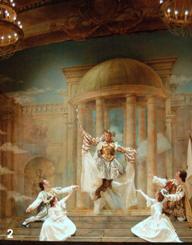 Thus Robert Donington, in a letter to the Times Literary Supplement of 7-14 October 1988. Thus Robert Donington, in a letter to the Times Literary Supplement of 7-14 October 1988.
As a youth, Donington,
though an Oxford man, presumably saw the 1925 Handel Semele produced at Cambridge by Dennis Arundell, who both directed
and designed the scenery, as well as the 1931 Fairy Queen. A three-page review of the 1925 performance by W. Barclay
Squire in The Musical Times offers not a word about any visual aspect of the performance [1], but
luckily we have Percy Scholes' comments in the next issue about a fan-tailed pigeon, four borzois and two goats, to clarify
matters (p.252), not to mention Edward Dent's remarks on the near-nudity [2]. In later
years, Donington must have seen Mozart staging that endeavoured - more or less - to reproduce original costumes and set designs,
but efforts to recreate original scenery, costumes and dance, stepped up in the thirties, were mainly confined to Handel opera
in Germany. The Oxford productions of Monteverdi operas in 1924 and 1926, by J. A. Westrup and R. L. Stuart (who translated
the libretti) had very simple sets but were choreographed "signifying the emotion proper to every scene and situation"
by Michael Martin Harvey [3]. So Robert Donington must have been knowledgeable about the issues
involved in staging baroque opera from very early on. Twenty years have passed since he aired his grievance.
How
Much Progress Has Been Made?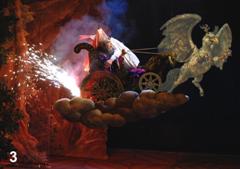
Without claiming to be comprehensive, we think some of the serious efforts at informed staging in the commercial
theatre are worth mentioning. The bi-annual Boston Early Music Festival has drawn worldwide attention with several well-researched
productions. The most recent was Lully's Psyché of 1678 (Illus. 1, above), staged by Gilbert Blin. Gary
Freeman's "Report from Boston" in Goldberg 47 (August 2007) devotes two columns to this "baroque opera
production that audiences dream about: music, stage effects and gesture reached a climax of achievement that is hard to describe
without overusing superlatives"(p.8). Every two or three years, the Handel Festival in Göttingen presents one of
Handel's operas with historically informed staging. In other years, regrettably, the staging is the updated kind that
can be seen anywhere. Atalanta was presented in May 2005 and in 2008 it was Orlando, both staged by Catherine
Turocy (Illus. 2 & 3, above l & r).
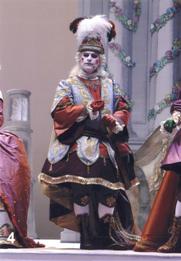 Outside these festivals there have been some commercial productions initiated either by an opera company or an early music
group, for instance Vivaldi's Rosmira fedele (2003) (illus. 4, left) and Handel's Teseo (2007)
(illus. 6, below left), both staged by Gilbert Blin for the Opéra de Nice; Monteverdi's Orfeo staged by
Gilbert Deflo for the Gran Teatre del Liceu in Barcelona (2002) (illus. 5, below, right)and Lully's Le bourgeois gentilhomme
(2004) and Cadmus et Hermione (2008) (illus. 7, below right) staged by Benjamin Lazar for Le poème harmonique,
in co-operation with the Centre de musique baroque de Versailles, among others. Even if we have missed a few, this is still
very little in a period of twenty years. Updated performances have been the norm. However, the latter ten years seem to have
yielded more informed productions than the former, so at least there seems to be some progress, although it might just be
that it has become easier to find out where promising productions are taking place. Alan Curtis recently pointed out (in Goldberg
50, p. 52) that "Baroque opera is an area that is particularly lively right now". Irritatingly, far too many reviewers
concentrate on the music to such an extent that one has to guess at the staging. Outside these festivals there have been some commercial productions initiated either by an opera company or an early music
group, for instance Vivaldi's Rosmira fedele (2003) (illus. 4, left) and Handel's Teseo (2007)
(illus. 6, below left), both staged by Gilbert Blin for the Opéra de Nice; Monteverdi's Orfeo staged by
Gilbert Deflo for the Gran Teatre del Liceu in Barcelona (2002) (illus. 5, below, right)and Lully's Le bourgeois gentilhomme
(2004) and Cadmus et Hermione (2008) (illus. 7, below right) staged by Benjamin Lazar for Le poème harmonique,
in co-operation with the Centre de musique baroque de Versailles, among others. Even if we have missed a few, this is still
very little in a period of twenty years. Updated performances have been the norm. However, the latter ten years seem to have
yielded more informed productions than the former, so at least there seems to be some progress, although it might just be
that it has become easier to find out where promising productions are taking place. Alan Curtis recently pointed out (in Goldberg
50, p. 52) that "Baroque opera is an area that is particularly lively right now". Irritatingly, far too many reviewers
concentrate on the music to such an extent that one has to guess at the staging.
Anti-opera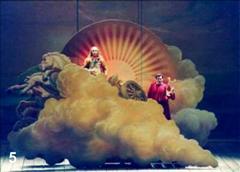
Why should we want historically informed opera productions?
Neither money nor effort has been spared to
put the most splendid historical instruments into the pit of the Muziektheater [Amsterdam opera]. And then you get this brat
of a director and he turns a Monteverdi opera into a contemporary psychodrama. In Monteverdi’s day music, action
and design were a unity. You can’t just tear these things loose from one another. That is
revolting, that is vulgar [My translation, JM].
Thus Gustav Leonhardt in an interview
with Oswin Schneeweisz for HP/De Tijd, a Dutch weekly, in May 2001 [4]. He was discussing
Pierre Audi’s staging of a cycle of Monteverdi productions by the Dutch National Opera Company, first performed during
the nineties in Amsterdam and partly in New York and San Francisco, and recently revived. If you only look at these pictures, you might ask what all the fuss is about, but anybody who has attended
the productions can understand why Leonhardt is so angry. Audi has made it his business to ensure that what the eye sees clashes
with what the ear hears. When, in Orfeo, Monteverdi writes dance music for shepherds, Audi’s shepherds will
just stand there like sheep (in the fifth act, they are sitting on the floor with the dirty soles of their feet exhibited
to the audience – a sign of the deepest contempt in many cultures). When Orfeo leaves the underworld, Audi makes him
descend a stairway. The lyre, so useful to him there, is broken in the second act in this production, but in the
fourth he nevertheless sings “Quel honor di te fia degno/Mia cetra omnipotente” [what honour is worthy
of thee, my omnipotent lyre]. The Styx, the absolute divide between life and death, is reduced to a shallow pond the characters
casually walk across and around. Audi has also deprived Charon of his boat, but the latter obviously hasn’t noticed
that yet as he sings “Pon freno al folle ardir, ch’entr’al mio legno non accorrò piu mai corporea
salma…” [Curb your foolish presumption, for never more shall a living body enter my boat…].
At the apotheosis Orfeo and Apollo sing “Saliam cantand’al Cielo” [singing we ascend to heaven]...
and amble offstage.
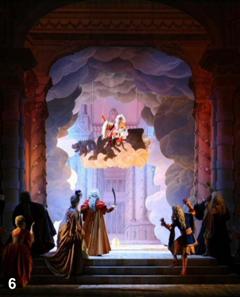 We come to the theatre prepared to believe in the weirdest fairy tale, provided it has internal logic. It is hard for us to
do so when the storyteller so clearly doesn’t; when the words and the music tell us a tale while we are looking at a
story book like Audi’s, full of illustrations that do not underline and often even undermine the narrative we are hearing.
If we understand a composite of arts to be the essence of opera then what we have here is anti-opera. Audi may well regard
this description of his work as a compliment. There is another: deception. The audience,
induced to come by the reputations of the musicians involved, has paid a great deal not just to hear, but also to see, for
once, the narrative context for which Monteverdi’s music was composed. They are constantly being distracted because
Audi is telling them a totally different story. It would have been more truthful to call this an Audi cycle. In co-operation
with one of today’s composers that might have led to interesting productions, as he has certainly proved himself capable
of fruitful collaboration with contemporary composers and designers, but he should have left Monteverdi alone. We come to the theatre prepared to believe in the weirdest fairy tale, provided it has internal logic. It is hard for us to
do so when the storyteller so clearly doesn’t; when the words and the music tell us a tale while we are looking at a
story book like Audi’s, full of illustrations that do not underline and often even undermine the narrative we are hearing.
If we understand a composite of arts to be the essence of opera then what we have here is anti-opera. Audi may well regard
this description of his work as a compliment. There is another: deception. The audience,
induced to come by the reputations of the musicians involved, has paid a great deal not just to hear, but also to see, for
once, the narrative context for which Monteverdi’s music was composed. They are constantly being distracted because
Audi is telling them a totally different story. It would have been more truthful to call this an Audi cycle. In co-operation
with one of today’s composers that might have led to interesting productions, as he has certainly proved himself capable
of fruitful collaboration with contemporary composers and designers, but he should have left Monteverdi alone. 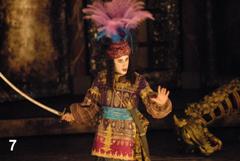
Audi’s work however pales by
comparison with what other directors get away with regarding early opera [5].
In 'Report from Boston' in Goldberg 37 (December 2005, p.6) Gary Freeman discusses a “shocking”
Handel Agrippina in which he describes a scene in which women sang while applying lipstick as being “like a
ventriloquist downing a glass of water while throwing his voice into the wings”, singing in odd positions “none
of which could have been easy, but [which] noticeably enhanced the streamlined staging”; “costumes [...] like
Macy’s autumn line” and, most curiously, “Handel used the long postlude to flatter the king by a short ballet,
but stage director Sam Helfrich choreographed something quite different, changing history forever”. What? Without revealing
what actually occurs to leave “the audience aghast”, the reviewer suggests that the reader may be “fortunate
enough” to see this “extraordinary performance”.
One could shrug all these modernizations off, if it weren’t for the fact that unified
productions in the commercial theatre are so few and far between. Vincent Dumestre of Le Poème Harmonique explains
in an interview with Yutha Tep in the same issue of Goldberg how and why his group preserves the necessary unity of approach:
“A work is more powerful when it retains its codes and structure, because it is closer to the original meaning and to
the reasons that led to its creation; these define the universality of a work. That is why it is pointless to try and make
a work modern in an artificial way; it is modern” (p.34).
The Narrative Whole
The public was first introduced to the phenomenon called opera during the period of transition between
the Renaissance and the baroque. Very soon changeable scenery was introduced, which was totally new at the time and a major
factor in the success of this innovative art form. The painted scenery, representing both reality and the supernatural, weighed
very little and could be moved easily. This made it possible to change the scenes in less than five seconds. For the first
time in history the audience could be transported from one place to another without leaving their seats. We have become used
to that since the invention of film, but to seventeenth-century audiences the experience was completely new. This kind of
staging gave strong visual support to the story that was being told in words and music.
The best baroque operas, the ones we
are still interested in today, were integrated works of art of which each component bore significance, with strong interaction
between the visual and the audible. The action on stage, particularly dance and the quick scene changes, affected the way
the music was performed. The weight of the costumes and headdresses, not to mention highheels, imposed tempos. Vincent Dumestre
(see above) says “[Seventeenth-century music] demands that the musician search for keys. And these keys are sometimes
hidden in unexpected places, in social and literary contexts, in works that use the same rhetoric – works for the theatre,
the dance and the fine arts” (p.30).
Winton Dean, interviewed by Graham Lock in Goldberg 46 (June 2007) explains: “... the traditional view
of the operas as static, as a dead form, was a mistake. The way they were performed in the eighteenth century, there was no
pause between scenes, no curtain, the scenery changed while the audience was looking at it, and the action went straight on.
You can tell this from the music, because Handel will suddenly go to a new key as the scene changes. It is quite certain that
the act was continuous”(p.35-37).
The story was told in pictures, as well as in words and music; in dance, gesture and posture, but also in properties and
scenery, in light and sound effects, in magical scenes with transformations and supernatural materializations. The theatres
contained a wide variety of machinery to achieve these things, some of which was highly sophisticated. This in turn led to
a strong iconographical tradition, comparable to affects in music and rhetoric in speech. Put together, the whole caused the
audience to understand what was happening on stage, even if some people had not understood the words in spite of all the repetition
or – as in ballet - there were no words. This is the unity to which Leonhardt alludes above.
The
Plague of the Opera
In our time the relationship has changed. Historically informed performance practice of baroque music has been
the subject of a huge amount of research during the past fifty years and people have re-learned how to build and play the
instruments. Sombre prognostications of fossilized musicianship have been refuted and all this has been achieved by a communal
effort. It is clear that early music is alive and well in many forms. There is a large public for it, now familiar with the
idiom. The situation with regard to opera is very different. Communality is anything but the norm. The visual aspect has become
more and more extreme and has retreated farther and farther from the period of its inception, even when this is quite recent,
let alone the baroque.
Musical splendour is the reason why masterpieces of the baroque music theatre are performed in our times. Monteverdi
said “l’oratione sia padrona del armonia e non serva” (see the forward to his fifth book of madrigals) which,
in free translation, means that the text dominates and does not serve the music, but after four centuries of opera it seems
clear that music has won. However, composers dead for three or four hundred years now have to compete with living dramaturges
and directors, professions unknown in their day, who now rule the theatrical roost and insist on stamping every production
with their own image. So they do what they have learned to do: stand between the audience and the original work of art, “translating”
it into an interpretation they consider “socially relevant”. We are not supposed to be able
to understand that there have been other times than our own, with people living under different conditions and therefore with
a different set of values. We are supposed to be unable to do what audiences in the seventeenth and eighteenth century could,
namely identify with characters of heroic, royal or supernatural stature from early Greece or Rome, because we are now a couple
of hundred years further on. We seem even to be thought incapable of empathy with basic human emotions such as love, hatred,
hope and despair, when in a historical setting.
The modern director’s stylistic device of choice seems to be translation to our own times. Once a shock effect, this
is now no more than a cliché and directors can no longer count on it to make an impression. As a result, staging is
becoming wilder and wilder. The singers are the primary victims of this trend. Most of them cannot afford to leave when it
all becomes too much. They have a living to earn, so they sing their most difficult arias lying on the stage, jumping up and
down on a mattress or doing other things that inhibit their breath control and distract their attention, sometimes even with
their backs to the audience. Famous conductors that might help correct this aberration by refusing to participate
in bad productions, mostly don’t. They would raise hell if asked to trade in the harpsichord for a piano, but counter-productive
staging doesn’t infuriate them enough to take action. In Goldberg 50 (Feb. 2008), Brian Robins launches
an all-out attack on “The perverse staging of early opera” (p.19), discussing “the ubiquitous, all-powerful,
self-serving directors who today plague the opera houses of the world. Where is the conductor who will stand up and say, ‘No
more. Enough is enough?’” Amen to that.
Obstacles to Overcome
People who organize ad hoc productions, frequently those who would love to do it all
correctly, are frustrated by lack of money, suitable theatres, technical and organizational facilities. They have to reinvent
the wheel again and again. Even productions during prestigious festivals show clear traces of this problem. During the performance
of Psyche in the BEMF of 2007 mentioned above, there was only one set of scenery, although the stage directions in
the libretto call for as many as seven scene changes. Zoroaster’s chariot in the production of Orlando at the
Göttingen Handel Festival of 2008, could not complete its ascent because the stage wasn’t wide enough. So the curtain
had to be brought down fast, in total disregard of the baroque theatre convention which decrees that the curtain almost never
falls during a performance. The magic fountain had to be left out as well, for the simple reason that there are no longer
traps in the stage floor.
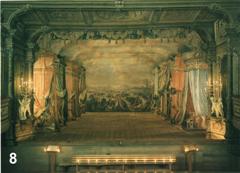 With regard to the few working baroque theatres we still have, conservation is the main purpose for which they are used. Preserved
scenery must not be exposed to the wear and tear of daily use. Many of these theatres are also very small, and working with
the original scenes and machines is too labour-intensive to be cost-effective (Illus 8, left). Today’s stringent
safety codes are also a barrier. With regard to the few working baroque theatres we still have, conservation is the main purpose for which they are used. Preserved
scenery must not be exposed to the wear and tear of daily use. Many of these theatres are also very small, and working with
the original scenes and machines is too labour-intensive to be cost-effective (Illus 8, left). Today’s stringent
safety codes are also a barrier.
The Drottningholm
baroque theatre (Illus. 9, below right) does operate as an opera house for part of the year and uses copies of the preserved
scenery, but that is all late eighteenth century and there isn’t very much. Without using new material, the number of
operas that can be staged is very limited, at least if one wants to do justice to the original. Drottningholm, with its special
“electric candles” does show us that modern lighting technique can create an atmosphere reasonably close to that
produced by eighteenth-century candles and oil lamps. It also proves that the human eye adjusts easily to low wattage.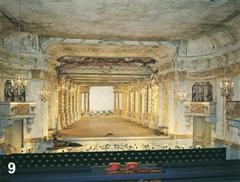
There is a lack of data, especially
connected with the visual aspects. At best there are sketches for costumes, machines and scenery, and sometimes an illustration
in a libretto (Illus. 10-13, below l & r). It varies from country to country. Relatively speaking, there is a lot
from France during Louis XIV’s reign and almost nothing from England at the same period. Scarce pictorial evidence can
be supplemented by data from other sources: account books which tell us what materials costumes were made of, diaries and
letters containing descriptions of performances. The comparison of stage directions is particularly valuable. As it was customary
to keep reusing scenery, the same piece is sometimes described differently in various libretti from the same theatre and period.
But this kind of research takes time and therefore long-term production planning. Also, historical research and theatre practice
are too often still separate spheres.
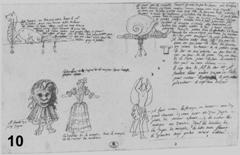 Most early music academies pay scant attention to the relationship between music and the other arts. Singers can complete
a specific early music course without having participated even once in a production deserving of the name baroque opera. Summer courses on baroque operas concentrate mainly on the music. The language is neglected and
at best the visual aspect is served by incorporating some demonstrations of dance and gesture. They are by definition too
short to accomplish much more. The only way to achieve good costumes and scenery and useful stage direction would be if the
course were the culmination of a much longer preparatory period and if all the other professionals needed for the performance
of an opera were involved as well. Most early music academies pay scant attention to the relationship between music and the other arts. Singers can complete
a specific early music course without having participated even once in a production deserving of the name baroque opera. Summer courses on baroque operas concentrate mainly on the music. The language is neglected and
at best the visual aspect is served by incorporating some demonstrations of dance and gesture. They are by definition too
short to accomplish much more. The only way to achieve good costumes and scenery and useful stage direction would be if the
course were the culmination of a much longer preparatory period and if all the other professionals needed for the performance
of an opera were involved as well. 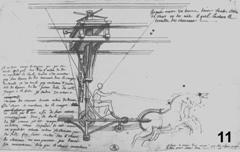
What Next?
Clearly, setting up integrated courses
is one of the first conditions for making progress. Baroque dance - wearing the appropriate costume and shoes - should be
obligatory for every musician wanting to specialize in early music. Baroque gesture and posture should be obligatory for singers,
as should historical phonology. The music profession should be involved in courses for opera directors. In October 2007 (Goldberg
42), Nicholas McGegan, in an interview with Graham Lock, complained that “... there are no qualifications to be an opera
director: you don’t have to read music, you don’t have to learn the languages. I heard of one director who didn’t
even know what a da capo was. When it was explained to him at the first rehearsal, his reaction was that they would all have
to be cut!” (p.40).
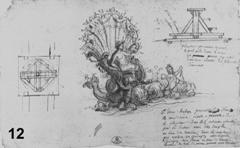 Baroque opera courses should teach students from all the relevant disciplines how to do research at graduate level and to
co-ordinate their research, emphatically including the fields of design and technique. The primary reason for this is of course
to prevent people from enthusiastically producing rubbish in an area about which they know nothing, but also to teach students
that research will always be indispensable even when, as a professional, one is under pressure of time. Co-ordinated research
can in itself contribute significantly to our knowledge of baroque music theatre, territory which still has many unmapped
spots. There is much still to be discovered in the no-man’s-land between theatre history and theatre
practice, for instance by connecting known facts not put together earlier because they were dispersed among several areas
of expertise. Investigating the interaction between the various arts is rewarding (for an example, see our article in Early
Music of November 2005). In conjunction with the full-time courses, there should be part-time courses for those already working
in the field and projects that help audiences to understand the idiom, the same way historically informed early music started
out. Baroque opera courses should teach students from all the relevant disciplines how to do research at graduate level and to
co-ordinate their research, emphatically including the fields of design and technique. The primary reason for this is of course
to prevent people from enthusiastically producing rubbish in an area about which they know nothing, but also to teach students
that research will always be indispensable even when, as a professional, one is under pressure of time. Co-ordinated research
can in itself contribute significantly to our knowledge of baroque music theatre, territory which still has many unmapped
spots. There is much still to be discovered in the no-man’s-land between theatre history and theatre
practice, for instance by connecting known facts not put together earlier because they were dispersed among several areas
of expertise. Investigating the interaction between the various arts is rewarding (for an example, see our article in Early
Music of November 2005). In conjunction with the full-time courses, there should be part-time courses for those already working
in the field and projects that help audiences to understand the idiom, the same way historically informed early music started
out.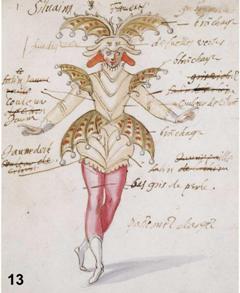
It will also be necessary to meet the
material conditions for creating all those marvellous baroque stage effects. As we have seen, both old and new theatres have
their limitations. So we need new “baroque theatres”, with modern equipment that not only adapts them to present-day
safety codes but is labour-saving and thus cost-effective. The use of modern technical means is quite compatible with the
reproduction of seventeenth-century effects, as long as we remember what their purpose is. Theatre will always be make-believe
and the suspension of disbelief does not depend on the use of real candles. It depends on making us, the audience, believe
in the miracle occurring on stage.
Happily,
there are initiatives in several parts of the world aimed at improving the situation. Although the plans for the Inigo Jones
Restoration Theatre, to be built next to The Globe in London, seem to have fizzled out, there are plans for a
theatre complex in Cambridge MA, which is to incorporate one constructed specifically for baroque productions [6]. For several years now, extensive research has been going on regarding the conditions the theatre
should meet. There are plans in Hungary for rebuilding the Eszterháza theatre to put on the Haydn
operas in their original form. The International Opera Foundation Eszterháza (IOFE), focusing on the Eszterháza
opera house, was established in 2006. Sigiswald Kuijken is one of the founding members. Now IOFE has adopted a Charter
on early opera performance, in collaboration with the French-based European Early Music Network and supported by the European
Festivals Association. Signatories to the Charter, which was signed on 6 December 2008, include among others Sigiswald
Kuijken, Gustav Leonhardt, Stephen Stubbs, Mark Tatlow, Max van Egmond and Malcolm Bilson. Its aims
include initiating collaborations among theatres and festivals, supporting new research and the integrated teaching of early
opera performance practice. TESEO, the Eszterháza School of Early Opera, would offer a graduate programme at which
students of music, dance and various theatre arts can be trained in the seventeenth and eighteenth-century techniques of their
own discipline [7]. Both projects are in the early stages and it will be years
before we can see results. This is no more than a drop in the ocean, but it is a beginning. More and more people are becoming
convinced that this is the way to go. Let us, as E. M. Forster urged creative minds, “only connect”.
[1]
The Musical Times, vol. 66, No. 984, 1 Feb. 1925, p.137-39.
[2]
Chapter 7 of Harry Haskell’s excellent The Early Music Revival, Thames and
Hudson (London, 1988) is entirely devoted to early opera staging from the end of the 19th century on. We need not duplicate
his absorbing overview. [3]
Haskell, p.141, F.S.H. [=Frank Howes], The Musical Times, vol. 67 (1 Jan. 1926),
p.61. [4]
See http://www.dno.nl for illustrations. [5]
See Heather Mac Donald on the excesses of director’s theatre, in The Abduction of
Opera at http://www.city-journal.org/html/17_3_urbanities-regietheater.html and Philippe Beaussant’s furious and hilarious polemic La Malscène (Fayard, 2005). [6]
See www.constellationcenter.org [7]
See www.esterhaza-opera.org
Until she retired, Julie
Muller taught English and American literature at the U. of Amsterdam graduate school. Her PhD thesis was published as Words
and Music in Henry Purcell's First Semi-Opera, Dioclesian (Lewiston, NY,1990) and the text of that opera appeared
in Henry Purcell's Operas: The Complete Texts ed. Michael Burden (Oxford, 2000).
jjg.muller@inter.nl.net
Frans Muller is a retired interior architect and theatre designer. He has written on Dorset Garden (where the Purcell
operas were first performed) for Theatre Notebook and was co-author with his wife of "Purcell's Dioclesian
on the Dorset Garden Stage" in Performing the Music of Henry Purcell ed. Michael Burden (Oxford,
1996).
f.muller@inter.nl.net
Details of Illustrations:
1. J. B. Lully, Psyché
(1678), Act II finale. In his palace Amor is being honoured by nymphs, zephyrs en cupids with song and dance.
2. G .F .Handel
Atalanta (1736), finale. William Berger (bass) as Mercury, during his descent. International Handel Festival, Göttingen,
2005. Musical director: Nicholas McGegan, staging and choreography: Catherine Turocy, stage design: Scott Blake, costume design:
Bonnie Kruger, lighting design: Pierre Dupouey. Photo:
Dorothea Heise.
3. G. F. Handel Orlando (1733),
Act II, Wolf Matthias Friedrich (bass) as the magician Zoroaster. His chariot is drawn by a hippogriff, described in Ariosto’s
Orlando furioso (with a pinch of Harry Potter). International Handel Festival, Göttingen, 2008. Musical director: Nicholas McGegan, staging and
choreography: Catherine Turocy, stage design: Scott Blake, costume design: Bonnie Kruger, lighting design: Pierre Dupouey. Photo: Dorothea Heise.
4. A. Vivaldi, Rosmira fedele (1738),
first revival. John Elwes (tenor) as Ormonte, in a costume of which the design was based on extensive research.
Opéra de Nice, 2003. Musical
director: Gilbert Bezzina, staging, scene design, costume design, lighting design: Gilbert Blin, historic research: Académie
Desprez. Photo: Rémy-Michel
Trotier, © Académie Desprez.
5. G. F. Handel, Teseo
(1713), Act IV. Theseus asleep, descending on a cloud. Opéra de Nice, 2007. Musical director: Gilbert Bezzina, staging, scene design, costume design,
lighting design: Gilbert Blin. Photo:
Jean Lec, © Académie Desprez.
6. C. Monteverdi l’Orfeo (1609), Act V, Fulvio Bettini (baritone) as Apollo and Furio Zanasi (baritone)
as Orfeo about to ascend to heaven. The design of the machine was inspired by a mural in the Gonzaga palace.
Gran Teatre del Liceu, Barcelona, 2002. Musical director:
Jordi Savall, staging: Gilbert Deflo, stage design: William Orlandi, choreography: Anna Casas, lighting: Albert Faura.
7. J-B. Lully Cadmus & Hermione (1673), André Morsch
(baritone) as Cadmus.
Le poème harmonique,
Opéra Comique, Paris, 2008. Musical direction: Vincent Dumestre, stage direction: Benjamin Lazar, scene design: Adeline
Caron, costumes: Alain Blanchot. Photo:
Elizabeth Carrechio.
8. Cesky
Krumlov, Castle theatre (1766), stage with scene of a military camp
Photo: Véroslav Skrabánek.
9. Slottsteater at Drottningholm
(1766). Auditorium and stage with palace scene and wave machine upstage. Photo: Olof Ekberg. 10. Annotated sketch by Jean Berain for scenes
in a revival of Amadis (1701?). Top left: Dragon that can be manipulated from under the stage. The tail comes off,
grows a new head and starts a life of its own. Bottom: transformation of a monster into a nymph. Archives nationales, Paris.
11. Annotated sketch by Jean Berain for the sun chariot in the finale of Phaéton (1683) Archives nationales, Paris.
12. Annotated sketch by Jean Berain for Venus’
chariot drawn by dolphins in La naissance de Venus (1696). Archives nationales, Paris.
13. Annotated sketch by Daniel Rabel for a costume in the ballet Les
Nymphes bocagères de la forest sacrée (1627)
Victoria & Albert
Museum, London.
RETURN TO TOP OF PAGERETURN TO TOP OF PAGE
RETURN TO HOME PAGE
|
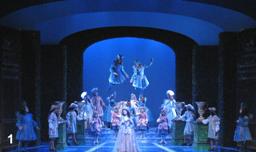
 Thus Robert Donington, in a letter to the Times Literary Supplement of 7-14 October 1988.
Thus Robert Donington, in a letter to the Times Literary Supplement of 7-14 October 1988.
 Outside these festivals there have been some commercial productions initiated either by an opera company or an early music
group, for instance Vivaldi's Rosmira fedele (2003) (illus. 4, left) and Handel's Teseo (2007)
(illus. 6, below left), both staged by Gilbert Blin for the Opéra de Nice; Monteverdi's Orfeo staged by
Gilbert Deflo for the Gran Teatre del Liceu in Barcelona (2002) (illus. 5, below, right)and Lully's Le bourgeois gentilhomme
(2004) and Cadmus et Hermione (2008) (illus. 7, below right) staged by Benjamin Lazar for Le poème harmonique,
in co-operation with the Centre de musique baroque de Versailles, among others. Even if we have missed a few, this is still
very little in a period of twenty years. Updated performances have been the norm. However, the latter ten years seem to have
yielded more informed productions than the former, so at least there seems to be some progress, although it might just be
that it has become easier to find out where promising productions are taking place. Alan Curtis recently pointed out (in Goldberg
50, p. 52) that "Baroque opera is an area that is particularly lively right now". Irritatingly, far too many reviewers
concentrate on the music to such an extent that one has to guess at the staging.
Outside these festivals there have been some commercial productions initiated either by an opera company or an early music
group, for instance Vivaldi's Rosmira fedele (2003) (illus. 4, left) and Handel's Teseo (2007)
(illus. 6, below left), both staged by Gilbert Blin for the Opéra de Nice; Monteverdi's Orfeo staged by
Gilbert Deflo for the Gran Teatre del Liceu in Barcelona (2002) (illus. 5, below, right)and Lully's Le bourgeois gentilhomme
(2004) and Cadmus et Hermione (2008) (illus. 7, below right) staged by Benjamin Lazar for Le poème harmonique,
in co-operation with the Centre de musique baroque de Versailles, among others. Even if we have missed a few, this is still
very little in a period of twenty years. Updated performances have been the norm. However, the latter ten years seem to have
yielded more informed productions than the former, so at least there seems to be some progress, although it might just be
that it has become easier to find out where promising productions are taking place. Alan Curtis recently pointed out (in Goldberg
50, p. 52) that "Baroque opera is an area that is particularly lively right now". Irritatingly, far too many reviewers
concentrate on the music to such an extent that one has to guess at the staging. 
 We come to the theatre prepared to believe in the weirdest fairy tale, provided it has internal logic. It is hard for us to
do so when the storyteller so clearly doesn’t; when the words and the music tell us a tale while we are looking at a
story book like Audi’s, full of illustrations that do not underline and often even undermine the narrative we are hearing.
If we understand a composite of arts to be the essence of opera then what we have here is anti-opera. Audi may well regard
this description of his work as a compliment. There is another: deception
We come to the theatre prepared to believe in the weirdest fairy tale, provided it has internal logic. It is hard for us to
do so when the storyteller so clearly doesn’t; when the words and the music tell us a tale while we are looking at a
story book like Audi’s, full of illustrations that do not underline and often even undermine the narrative we are hearing.
If we understand a composite of arts to be the essence of opera then what we have here is anti-opera. Audi may well regard
this description of his work as a compliment. There is another: deception
 With regard to the few working baroque theatres we still have, conservation is the main purpose for which they are used. Preserved
scenery must not be exposed to the wear and tear of daily use. Many of these theatres are also very small, and working with
the original scenes and machines is too labour-intensive to be cost-effective (Illus 8, left). Today’s stringent
safety codes are also a barrier.
With regard to the few working baroque theatres we still have, conservation is the main purpose for which they are used. Preserved
scenery must not be exposed to the wear and tear of daily use. Many of these theatres are also very small, and working with
the original scenes and machines is too labour-intensive to be cost-effective (Illus 8, left). Today’s stringent
safety codes are also a barrier. 
 Most early music academies pay scant attention to the relationship between music and the other arts. Singers can complete
a specific early music course without having participated even once in a production deserving of the name
Most early music academies pay scant attention to the relationship between music and the other arts. Singers can complete
a specific early music course without having participated even once in a production deserving of the name
 Baroque opera courses should teach students from all the relevant disciplines how to do research at graduate level and to
co-ordinate their research, emphatically including the fields of design and technique. The primary reason for this is of course
to prevent people from enthusiastically producing rubbish in an area about which they know nothing, but also to teach students
that research will always be indispensable even when, as a professional, one is under pressure of time. Co-ordinated research
can in itself contribute significantly to our knowledge of baroque music theatre, territory which still has many unmapped
spots.
Baroque opera courses should teach students from all the relevant disciplines how to do research at graduate level and to
co-ordinate their research, emphatically including the fields of design and technique. The primary reason for this is of course
to prevent people from enthusiastically producing rubbish in an area about which they know nothing, but also to teach students
that research will always be indispensable even when, as a professional, one is under pressure of time. Co-ordinated research
can in itself contribute significantly to our knowledge of baroque music theatre, territory which still has many unmapped
spots.